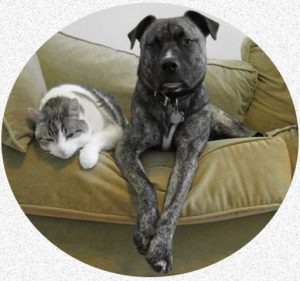Ron Hines DVM PhD
Some Other Articles On Liver Problems:
After digestion, your pet’s liver is the first stop for all the things that your dog and cat eats. It is the liver’s primary job to sort through them, identify each one and rework (process) each one of them in unique ways before allowing beneficial nutrients and compounds to enter your pet’s general blood stream. It is also the liver’s job to see to it that undesirable ones never get there. Once nutrients pass through the liver, they become the building blocks or energy for cells throughout your pet’s body.
The liver is also the first stop for ingested toxins, drugs and undesirable compounds that enter your pet’s body. The liver does its best to neutralize compounds that pose a health threat. There are plenty of those potentially toxic compounds that dogs and cats are exposed to. That is particularly true in our polluted urban environment, when inappropriate food items are eaten and when their diets consist of processed pet foods. (read here, here & here)
When you see a TV ad where the pet’s owner eats a spoonful of their own dog or cat’s food, that brand is probably as safe for your pet as it is for you. But foods processed and sold specifically for pets tend to have “second class ingredients” that can be quite hard on the liver. Do you see the Mars family eating Royal Canin? (read here)
A healthy liver has a remarkable ability to identify toxic substances and choose the best way to detoxify them. The same goes for toxic waste products of your pet’s own normal metabolism. Some, like ammonia and certain bile acids, are known to be toxic – but many remain unknown. When those undesirable substances cause liver damage, healthy livers rapidly regenerate new hepatocytes to take the place of those that were injured by those agents. Only blood and skin (both are also organs) share that remarkable ability for regeneration.
You probably found this webpage because your veterinarian told you that your pet’s liver is no long able to regenerate its lost liver cells (hepatocytes). In that situation, your pet can no longer clear toxic substances from its body as well as it once did. Or perhaps your pet was born with an abnormally constructed liver that allows unprocessed blood to bypass it (portosystemic shunts, hepatic microdysplasia). Or perhaps those bypasses and short circuits developed later due to extensive liver damage. Perhaps a genetic defect your dog or cat was born with left it unable to process copper. (read here & here)
If your pet were a human being, your physician might tell you that he/she had medications that might help, and suggest lifestyle changes that would also help for a time. They might reassure you that if and when your problem could no longer be managed with medications, a liver transplant would be an option. Veterinarians can’t offer you that for your pet – yet. You can see some of those medication and diet options here, here & here. You can read about some of the medications that help humans with failing livers here. I wish we veterinarians had medication at this time that could offer more.
There are other things you might try. For one, the remaining healthy liver cells that your dog or cat still has undergo less stress when food is offered in smaller amounts – but more frequently throughout the day, so its daily needs are still met. Weigh your pet to be sure its daily food intake maintains its healthy body weight.
You might also try to vary the times of day when you offer food to your pet. A recent study in laboratory animals found that livers expand and shrink and change their capacity to perform their tasks depending on the time of day (up to 40%). In nocturnal animals that feed mostly at night, their livers are the largest (and most capable) during the night. In humans, the reverse is the case. In dog’s and cats, we do not know. You can read about that here.
You are on the Vetspace animal health website
Visiting the products that you see displayed on this website help pay the cost of keeping these articles on the Internet.
